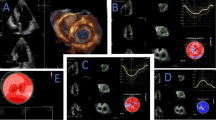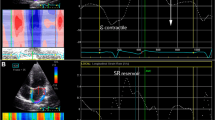Abstract
The present study investigated the changes of biventricular mechanics at rest and during exercise and examined the association between exercise capacity and biventricular mechanics and functional reserve in nonobstructive hypertrophic cardiomyopathy (NHCM) patients. A total of 50 NHCM patients and 25 controls were consecutively recruited for this study. Using echocardiography and two-dimensional speckle-tracking imaging, an experienced echocardiographer determined the following indices: RV free wall longitudinal strain (RVFWLS), LV global longitudinal strain (LVGLS), strain rate (SR), and functional reserve of strain values. We also investigated the relationships between biventricular mechanics and exercise capacity using metabolic equivalents (METs). NHCM patients had lower RVFWLS, LVGLS, systolic SR, early diastolic SR, and systolic and diastolic reserve during exercise compared to controls. An association of biventricular mechanics (LVGLS, RVFWLS) with exercise capacity at rest and during exercise was established. Multivariable logistic regression revealed that RVFWLS and LVE/e′ during exercise (RVFWLS-exe, E/e′-exe) were independent predictors of exercise intolerance. Receiver operating characteristic curve analysis indicated that LVE/e′-exe had a higher area under the curve for predicting exercise intolerance in NHCM patients. In hierarchical analysis, RVFWLS-exe provided an incremental predictive value of exercise intolerance over LVGLS during exercise (LVGLS-exe) and LVE/e′-exe. LVE/e′-exe also changed incrementally compared to LVGLS-exe and RVFWLS-exe. NHCM patients have decreased biventricular mechanics at rest and during exercise and impaired biventricular functional reserve, and biventricular mechanics are associated with functional capacity. We propose that simultaneous evaluation of biventricular function should provide incremental predictive value for exercise intolerance.




Similar content being viewed by others
References
Gersh BJ, Maron BJ, Bonow RO et al (2011) 2011 ACCF/AHA guideline for the diagnosis and treatment of hypertrophic cardiomyopathy: executive summary: a report of the American College of Cardiology Foundation/American Heart Association Task Force on Practice Guidelines. Circulation 124:2761–2796
Maron BJ, Maron MS (2013) Hypertrophic cardiomyopathy. Lancet 381:242–255
Tower-Rader A, Betancor J, Lever HM, Desai MY (2017) A comprehensive review of stress testing in hypertrophic cardiomyopathy: assessment of functional capacity, identification of prognostic indicators, and detection of coronary artery disease. J Am Soc Echocardiogr 30:829–844
Efthimiadis GK, Giannakoulas G, Parcharidou DG et al (2011) Chronotropic incompetence and its relation to exercise intolerance in hypertrophic cardiomyopathy. Int J Cardiol 153:179–184
Geske JB, Ommen SR, Gersh BJ (2018) Hypertrophic cardiomyopathy: clinical update. JACC Heart Fail 6:364–375
Peteiro J, Bouzas-Mosquera A, Fernandez X, Monserrat L, Pazos P, Estevez-Loureiro R, Castro-Beiras A (2012) Prognostic value of exercise echocardiography in patients with hypertrophic cardiomyopathy. J Am Soc Echocardiogr 25:182–189
Desai MY, Bhonsale A, Patel P, Naji P, Smedira NG, Thamilarasan M, Lytle BW, Lever HM (2014) Exercise echocardiography in asymptomatic HCM: exercise capacity, and not LV outflow tract gradient predicts long-term outcomes. JACC Cardiovasc Imaging 7:26–36
Maron MS, Rowin EJ, Olivotto I et al (2016) Contemporary natural history and management of nonobstructive hypertrophic cardiomyopathy. J Am Coll Cardiol 67:1399–1409
Maron BJ, Rowin EJ, Maron MS, Braunwald E (2017) Nonobstructive hypertrophic cardiomyopathy out of the shadows: known from the beginning but largely ignored … until now. Am J Med 130:119–123
Pozios I, Corona-Villalobos C, Sorensen LL et al (2015) Comparison of outcomes in patients with nonobstructive, labile-obstructive, and chronically obstructive hypertrophic cardiomyopathy. Am J Cardiol 116:938–944
Pozios I, Pinheiro A, Corona-Villalobos C et al (2018) Rest and stress longitudinal systolic left ventricular mechanics in hypertrophic cardiomyopathy: implications for prognostication. J Am Soc Echocardiogr 31:578–586
Pelliccia F, Pasceri V, Limongelli G et al (2017) Long-term outcome of nonobstructive versus obstructive hypertrophic cardiomyopathy: a systematic review and meta-analysis. Int J Cardiol 243:379–384
D’Andrea A, Limongelli G, Baldini L et al (2017) Exercise speckle-tracking strain imaging demonstrates impaired right ventricular contractile reserve in hypertrophic cardiomyopathy. Int J Cardiol 227:209–216
Rowin EJ, Maron BJ, Olivotto I, Maron MS (2017) Role of exercise testing in hypertrophic cardiomyopathy. JACC Cardiovasc Imaging 10:1374–1386
Lancellotti P, Pellikka PA, Budts W et al (2017) The clinical use of stress echocardiography in non-ischaemic heart disease: recommendations from the European association of cardiovascular imaging and the American Society of Echocardiography. J Am Soc Echocardiogr 30:101–138
Tower-Rader A, Mohananey D, To A, Lever HM, Popovic ZB, Desai MY (2018) Prognostic value of global longitudinal strain in hypertrophic cardiomyopathy: a systematic review of existing literature. JACC Cardiovasc Imaging. https://doi.org/10.1016/j.jcmg.2018.07.016
Smiseth OA, Torp H, Opdahl A, Haugaa KH, Urheim S (2016) Myocardial strain imaging: how useful is it in clinical decision making? Eur Heart J 37:1196–1207
Authors/Task Force m, Elliott PM, Anastasakis A et al (2014) 2014 ESC Guidelines on diagnosis and management of hypertrophic cardiomyopathy: the task force for the diagnosis and management of hypertrophic cardiomyopathy of the european society of cardiology (ESC). Eur Heart J 35:2733–2779
Lang RM, Badano LP, Mor-Avi V et al (2015) Recommendations for cardiac chamber quantification by echocardiography in adults: an update from the American Society of Echocardiography and the European Association of Cardiovascular Imaging. Eur Heart J Cardiovasc Imaging 16:233–270
Badran HM, Faheem N, Ibrahim WA, Elnoamany MF, Elsedi M, Yacoub M (2013) Systolic function reserve using two-dimensional strain imaging in hypertrophic cardiomyopathy: comparison with essential hypertension. J Am Soc Echocardiogr 26:1397–1406
Gersh BJ, Maron BJ, Bonow RO et al (2011) 2011 ACCF/AHA Guideline for the Diagnosis and Treatment of Hypertrophic Cardiomyopathy: a report of the American College of Cardiology Foundation/American Heart Association Task Force on Practice Guidelines. Developed in collaboration with the American Association for Thoracic Surgery, American Society of Echocardiography, American Society of Nuclear Cardiology, Heart Failure Society of America, Heart Rhythm Society, Society for Cardiovascular Angiography and Interventions, and Society of Thoracic Surgeons. J Am Coll Cardiol 58:e212–e260
Maron BJ, Rowin EJ, Udelson JE, Maron MS (2018) Clinical spectrum and management of heart failure in hypertrophic cardiomyopathy. JACC Heart Fail 6:353–363
Carasso S, Yang H, Woo A, Vannan MA, Jamorski M, Wigle ED, Rakowski H (2008) Systolic myocardial mechanics in hypertrophic cardiomyopathy: novel concepts and implications for clinical status. J Am Soc Echocardiogr 21:675–683
Moneghetti KJ, Stolfo D, Christle JW, Kobayashi Y, Finocchiaro G, Sinagra G, Myers J, Ashley EA, Haddad F, Wheeler MT (2017) Value of strain imaging and maximal oxygen consumption in patients with hypertrophic cardiomyopathy. Am J Cardiol 120:1203–1208
Choi EY, Ha JW, Rim SJ, Kim SA, Yoon SJ, Shim CY, Kim JM, Jang Y, Chung N, Cho SY (2008) Incremental value of left ventricular diastolic function reserve index for predicting exercise capacity in patients with hypertrophic cardiomyopathy. J Am Soc Echocardiogr 21:487–492
Nagueh SF, Smiseth OA, Appleton CP et al (2016) Recommendations for the evaluation of left ventricular diastolic function by echocardiography: an update from the american society of echocardiography and the european association of cardiovascular imaging. J Am Soc Echocardiogr 29:277–314
Kitaoka H, Kubo T, Hayashi K, Yamasaki N, Matsumura Y, Furuno T, Doi YL (2013) Tissue Doppler imaging and prognosis in asymptomatic or mildly symptomatic patients with hypertrophic cardiomyopathy. Eur Heart J Cardiovasc Imaging 14:544–549
Okada K, Yamada S, Iwano H et al (2015) Myocardial shortening in 3 orthogonal directions and its transmural variation in patients with nonobstructive hypertrophic cardiomyopathy. Circ J 79:2471–2479
Nucifora G, Muser D, Gianfagna P, Morocutti G, Proclemer A (2015) Systolic and diastolic myocardial mechanics in hypertrophic cardiomyopathy and their link to the extent of hypertrophy, replacement fibrosis and interstitial fibrosis. Int J Cardiovasc Imaging 31:1603–1610
Cheng TO (2008) Hypertrophic cardiomyopathy is a biventricular disease. Int J Cardiol 129:3–4
Rosca M, Calin A, Beladan CC et al (2015) Right ventricular remodeling, its correlates, and its clinical impact in hypertrophic cardiomyopathy. J Am Soc Echocardiogr 28:1329–1338
Pagourelias ED, Efthimiadis GK, Parcharidou DG, Gossios TD, Kamperidis V, Karoulas T, Karvounis H, Styliadis IH (2011) Prognostic value of right ventricular diastolic function indices in hypertrophic cardiomyopathy. Eur J Echocardiogr 12:809–817
Afonso L, Briasoulis A, Mahajan N, Kondur A, Siddiqui F, Siddiqui S, Alesh I, Cardozo S, Kottam A (2015) Comparison of right ventricular contractile abnormalities in hypertrophic cardiomyopathy versus hypertensive heart disease using two dimensional strain imaging: a cross-sectional study. Int J Cardiovasc Imaging 31:1503–1509
Guo X, Fan C, Wang H, Zhao S, Duan F, Wang Z, Yan L, Yang Y, An S, Li Y (2016) The prevalence and long-term outcomes of extreme right versus extreme left ventricular hypertrophic cardiomyopathy. Cardiology 133:35–43
Marian AJ, Braunwald E (2017) Hypertrophic cardiomyopathy: genetics, pathogenesis, clinical manifestations, diagnosis, and therapy. Circ Res 121:749–770
Lu DY, Pozios I, Haileselassie B, Ventoulis I, Liu H, Sorensen LL, Canepa M, Phillip S, Abraham MR, Abraham TP (2018) Clinical outcomes in patients with nonobstructive, labile, and obstructive hypertrophic cardiomyopathy. J Am Heart Assoc 7:e006657
Acknowledgements
We are very grateful to all subjects for their participation and other colleagues for their support.
Funding
The present study was supported by the National Natural Science Foundation of China (NSFC No. 81571683), Beijing Chao-yang Hospital 1351 Talent Training Plan (No. CYMY-2017-28).
Author information
Authors and Affiliations
Corresponding author
Ethics declarations
Conflict of interest
The authors declare that they have no conflict of interest.
Ethical approval
This study was approved by the local ethics committee. All procedures performed in studies involving human participants were in accordance with the ethical standards of the institutional and/or national research committee and with the 1964 Helsinki declaration and its later amendments or comparable ethical standards.
Informed consent
Written informed consent was obtained from all individual participants included in the study.
Additional information
Publisher's Note Springer Nature remains neutral with regard to jurisdictional claims in published maps and institutional affiliations.
Electronic supplementary material
Below is the link to the electronic supplementary material.
Supplemental Figure 1
. Flowchart showing the enrollment of subjects in the study. PCI = percutaneous coronary intervention (TIF 192 KB)
Rights and permissions
About this article
Cite this article
Wu, XP., Li, YD., Wang, YD. et al. Decreased biventricular mechanics and functional reserve in nonobstructive hypertrophic cardiomyopathy patients: implications for exercise capacity. Int J Cardiovasc Imaging 35, 869–879 (2019). https://doi.org/10.1007/s10554-019-01530-y
Received:
Accepted:
Published:
Issue Date:
DOI: https://doi.org/10.1007/s10554-019-01530-y




